Leslie Young's Comet talk, Aug 1997
Public lecture for the Quincy Bog, Rumney N. H., August 13 1997
This page contains the notes I made to myself to prepare for a public talk at
the Quincy Bog Nature Preserve in my parent's town of Rumney, New Hampshire.
I have included here on the web so that (1) I can find it again :) and
(2) other people might find it interesting.
This talk was given just after the
1997 AAS division of Planetary Sciences meeting, so I was able to
work in some very recent results. Other source for recent comet
information was found at the following sites:
hale-bopp,
nineplanets ,
stsci ,
arcorp ,
jpl ,
jpl/hale-bopp orbit? ,
Sommers-Bausch Observatory (Hyakutake vs Hale-Bopp) ,
Sky and Tel comet page.
If you'd like to see the original sites for these images, I have
collected just the images, with their original captions and
links back to the source sites, on the a
separate page.
I was in a taxi in Boston last spring, and I asked the cabbie if he'd
seen the comet Hale-Bopp yet. He hadn't, so at the next stoplight, I
pointed it out to him. Hale-Bopp was a bright enough comet to be
easily seen, even from inside a car, on a lgihted street, in the
middle of the city.
I'm sure it was even brighter up here. Who saw Hale-Bopp last spring?
And who saw the comet Hyakutake the year before?
Which did you like better?
They were very different comets, weren't they?
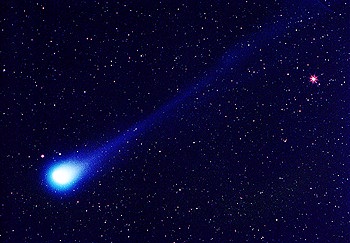 Hyakutake was discovered only in January 1996, and already by the biggining
of March it
was visible. It was
visible just a few weeks at the end of March, beginning of April,
but was up all night, and
had a really good tail from dark sites.
Some people reported seeing a tail that was 30, 40, 50, even 100 degrees long.
Approached the Earth March 24-25.
Hyakutake was discovered only in January 1996, and already by the biggining
of March it
was visible. It was
visible just a few weeks at the end of March, beginning of April,
but was up all night, and
had a really good tail from dark sites.
Some people reported seeing a tail that was 30, 40, 50, even 100 degrees long.
Approached the Earth March 24-25.
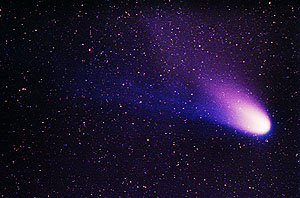 Hale-Bopp was discovered July 1995.
Hale-Bopp was bright, but only visible at sunrise at the beginning and
then, later, just after sunset. Visible for several months.
Here we see that Hale-Bopp was "stubbier." Also we see two
tails here. One is bluer, and that's the "ion tail." and
the other one is less blue, and that's the dust tail.
Why are the comets so different? Before we do that, we have to
talk about what a comet is. In 1950, Fred Whipple wrote a paper
describing comets as "dirty snowballs."
And that basic description has held up, even though some scientist
will quibble and say that comets are really "icy mudballs."
In any case, they are a mixture of rock and frozen water, with
some other things mixed in. Methane, ammonia, other gases.
Hale-Bopp was discovered July 1995.
Hale-Bopp was bright, but only visible at sunrise at the beginning and
then, later, just after sunset. Visible for several months.
Here we see that Hale-Bopp was "stubbier." Also we see two
tails here. One is bluer, and that's the "ion tail." and
the other one is less blue, and that's the dust tail.
Why are the comets so different? Before we do that, we have to
talk about what a comet is. In 1950, Fred Whipple wrote a paper
describing comets as "dirty snowballs."
And that basic description has held up, even though some scientist
will quibble and say that comets are really "icy mudballs."
In any case, they are a mixture of rock and frozen water, with
some other things mixed in. Methane, ammonia, other gases.
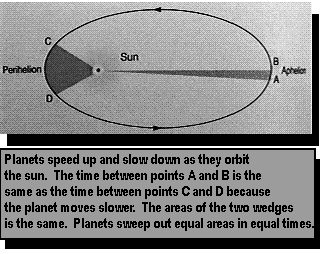 Comets orbit the sun in ellipses, just like Earth and the other planets do.
But the orbits of the comets are long and stretched out. We say
the orbits are "eccentric" (and some of the people studying comets
are eccentric as well.) And like all the objects that orbit the
sun, the comet moves fastest when it is closest to the sun.
This means that a comet would be a lousy place to live. You'd
spent 20 to 20,000 years in cold darkness. Then boom -- a few
warm months, maybe too warm, and then you zip back out to the
outer solar system again.
Comets orbit the sun in ellipses, just like Earth and the other planets do.
But the orbits of the comets are long and stretched out. We say
the orbits are "eccentric" (and some of the people studying comets
are eccentric as well.) And like all the objects that orbit the
sun, the comet moves fastest when it is closest to the sun.
This means that a comet would be a lousy place to live. You'd
spent 20 to 20,000 years in cold darkness. Then boom -- a few
warm months, maybe too warm, and then you zip back out to the
outer solar system again.
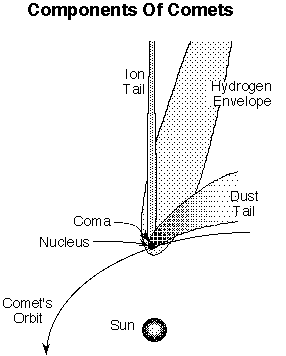 The sun is so faint out past Saturn that ice acts like rock.
It doesn't melt ... it doesn't even sublime straight from ice to
gas, the way ice cubes do when you fill your tray, and then 3 months
later you check the freezer and the ice cubes trays all look like they're
half full.
At this time, comets are just the small, nucleus of the dirty snowball.
They are tiny. Typically just a few km across.
Even comet Halley is only 7-10 miles across,
you could bike around a comet in a few hours.
Also comets are very dark. Darker than charcoal.
This means that most of the time, comets are vary hard to detect, even
with major telescopes. There's only a few people studying distant comets.
When a comet approaches the inner solar system, everything changes.
As the sun heats up the surface, gas begins to escape
from the comet. It takes the dust up with it, like a wind picking up dust.
This is small dust -- smoke-particle size. Eventually, the dust and gas
makes a large diffuse cloud around the comet, and you get a "coma,"
the gas and dust around the comet, about 100,000 km = tens of thousands of mi
wide. This is what makes the comet look "fuzzy". The gases in the
coma come from the comet nucleus: water, carbon monoxide, carbon dioxide,
some methane, some ammonia, some other stuff.
As the comet gets closer to the sun, the comet grows tails.
The skinny blue tail is the ion tail. This is made of electrically
charged gases, and it points directly away from the sun, because the
charged gases are trapped in the Sun's magnetric field. The other
tail is made up of dust, and the radiation pressure of the
sunlight pushes it more-or-less away from the sun, but this
tail CAN curve away from the strict anti-solar direction, so you
see two tails. Pretty. Hale-Bopps' tail was 50-60 million miles long.
The sun is so faint out past Saturn that ice acts like rock.
It doesn't melt ... it doesn't even sublime straight from ice to
gas, the way ice cubes do when you fill your tray, and then 3 months
later you check the freezer and the ice cubes trays all look like they're
half full.
At this time, comets are just the small, nucleus of the dirty snowball.
They are tiny. Typically just a few km across.
Even comet Halley is only 7-10 miles across,
you could bike around a comet in a few hours.
Also comets are very dark. Darker than charcoal.
This means that most of the time, comets are vary hard to detect, even
with major telescopes. There's only a few people studying distant comets.
When a comet approaches the inner solar system, everything changes.
As the sun heats up the surface, gas begins to escape
from the comet. It takes the dust up with it, like a wind picking up dust.
This is small dust -- smoke-particle size. Eventually, the dust and gas
makes a large diffuse cloud around the comet, and you get a "coma,"
the gas and dust around the comet, about 100,000 km = tens of thousands of mi
wide. This is what makes the comet look "fuzzy". The gases in the
coma come from the comet nucleus: water, carbon monoxide, carbon dioxide,
some methane, some ammonia, some other stuff.
As the comet gets closer to the sun, the comet grows tails.
The skinny blue tail is the ion tail. This is made of electrically
charged gases, and it points directly away from the sun, because the
charged gases are trapped in the Sun's magnetric field. The other
tail is made up of dust, and the radiation pressure of the
sunlight pushes it more-or-less away from the sun, but this
tail CAN curve away from the strict anti-solar direction, so you
see two tails. Pretty. Hale-Bopps' tail was 50-60 million miles long.
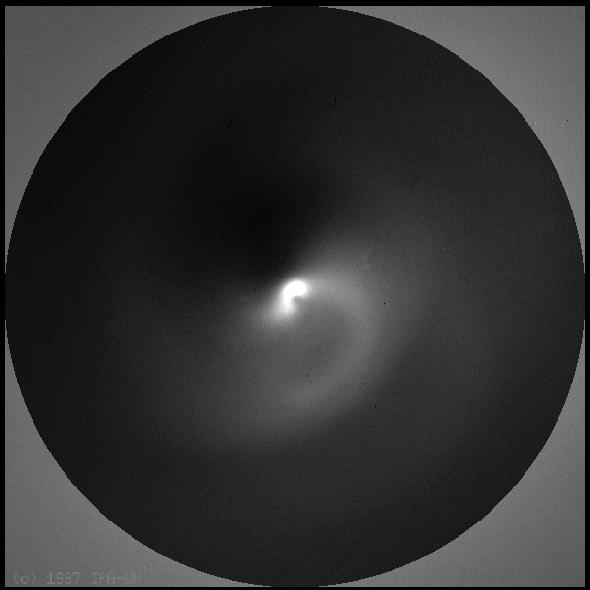 When you look at the very center of the comet with a good telescope,
you can see a spiral. The gases are not coming out smoothly.
Instead it is coming out as jets. And as the nucleus rotates,
you get a spiral.
When you look at the very center of the comet with a good telescope,
you can see a spiral. The gases are not coming out smoothly.
Instead it is coming out as jets. And as the nucleus rotates,
you get a spiral.
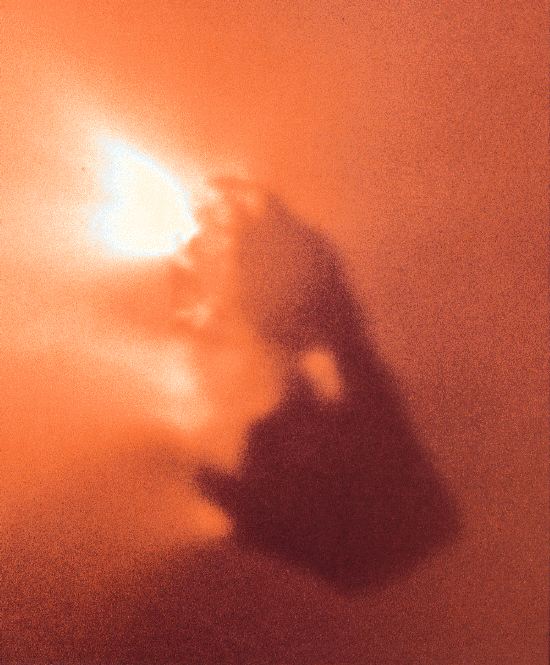 This is because a crust is forming. Each time the comet passes
near the sun, it can loose several yards of ice and dust. The ice
leaves more easily than the dust ... after all, it's the ice
that sublimes,and the dust just comes along for the ride. The result
is that the dust is left behind. Like a huge, extreme version of
what happens to the pile of snow plowed into the corner of the
parking lot. Where the crust is thinner, that's where you'll
have the jets.
This is because a crust is forming. Each time the comet passes
near the sun, it can loose several yards of ice and dust. The ice
leaves more easily than the dust ... after all, it's the ice
that sublimes,and the dust just comes along for the ride. The result
is that the dust is left behind. Like a huge, extreme version of
what happens to the pile of snow plowed into the corner of the
parking lot. Where the crust is thinner, that's where you'll
have the jets.
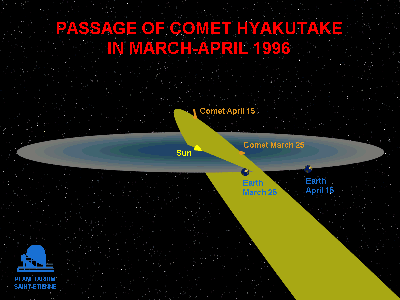 So what does this have to do with why Hale-Bopp and Hyakutake looked
so different? Hyakutake was actually not much of a comet.
Its nucleus was only about 1 mi across. It had hardly any dust.
Since it was so naturally dim, it was only discovered a few months
before it was visible. But, it had a great orbit!
Look how close to the Earth it got. This is the orbit of the
Earth, and this is the sun, and this is Hyakutake, screaming in
on this long, streached-out orbit. In March, it's 1/10 the
distance from us as the sun is. And it's nearly north of the
Earth, which means that we lucky Norhtern herisphere folks
could watch it all night.
So what does this have to do with why Hale-Bopp and Hyakutake looked
so different? Hyakutake was actually not much of a comet.
Its nucleus was only about 1 mi across. It had hardly any dust.
Since it was so naturally dim, it was only discovered a few months
before it was visible. But, it had a great orbit!
Look how close to the Earth it got. This is the orbit of the
Earth, and this is the sun, and this is Hyakutake, screaming in
on this long, streached-out orbit. In March, it's 1/10 the
distance from us as the sun is. And it's nearly north of the
Earth, which means that we lucky Norhtern herisphere folks
could watch it all night.
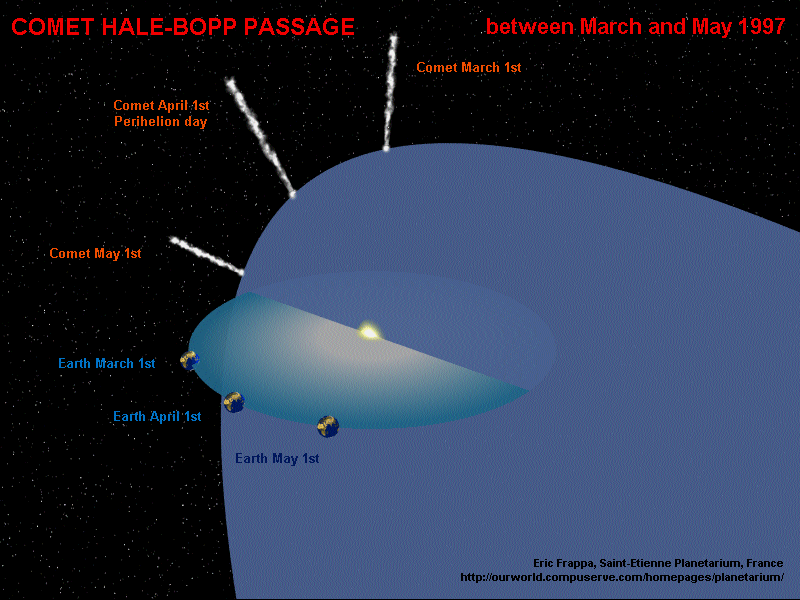 Hale-Bopp also has a stretched-out orbit, but not nearly so skinny.
That means that it has a smaller orbit than Hyakutake, and so a
shorter period. Hale-Bopp was last here 4300 years ago,
Hale-Bopp last visited us 4300 years ago. Will visit us again 2300 years
from now.
Hyakutake last visited us 17,500 years ago and will not return for
another 29,500 years.
Like Hyakutake, the orbit is coming up at right angles to the
plane the planets generally move in.
But, unlike Hyakutake, the comet only got a little closer to us
that the sun is (0.9 AU).
HB was 100x brigher, but 13 times farther.
Also, since the tail always points away
from the sun, like a windsock, the tail is forshortened. Still,
since Hale-Bopp is a dusty, large comet, it was still bright.
And we say it coming a year and a half in advance. It's twice as
big as Halley's comet.
Hale-Bopp also has a stretched-out orbit, but not nearly so skinny.
That means that it has a smaller orbit than Hyakutake, and so a
shorter period. Hale-Bopp was last here 4300 years ago,
Hale-Bopp last visited us 4300 years ago. Will visit us again 2300 years
from now.
Hyakutake last visited us 17,500 years ago and will not return for
another 29,500 years.
Like Hyakutake, the orbit is coming up at right angles to the
plane the planets generally move in.
But, unlike Hyakutake, the comet only got a little closer to us
that the sun is (0.9 AU).
HB was 100x brigher, but 13 times farther.
Also, since the tail always points away
from the sun, like a windsock, the tail is forshortened. Still,
since Hale-Bopp is a dusty, large comet, it was still bright.
And we say it coming a year and a half in advance. It's twice as
big as Halley's comet.
This has been a great chance to study comets, and I'll just
quickly tell you some of the new things we've learned.
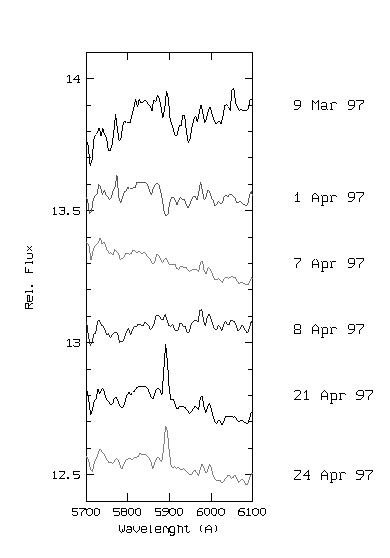 See, gas molecules emit light (shine) at specific wavelengths (colors).
This is called a spectrum.
If you plot brightness as a function of wavelength, you see what
molecules are in the comet because of the spectrum.
It's like a fingerprint,
each molecule shines at it's own colors. Here's a spectrum of Hale-Bopp
showing the sodium lines in late April.
See, gas molecules emit light (shine) at specific wavelengths (colors).
This is called a spectrum.
If you plot brightness as a function of wavelength, you see what
molecules are in the comet because of the spectrum.
It's like a fingerprint,
each molecule shines at it's own colors. Here's a spectrum of Hale-Bopp
showing the sodium lines in late April.
Hale-Bopp added a new kind of tail to the mixture. A sodium tail.
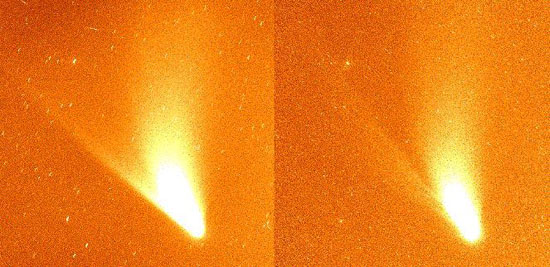 Observers at La Palma telescope in Spain at 18 April 1997 took images with
a filter that isolates emission from sodium atoms. In other words, they
used a finter that blocked off all but this part, and then they
took an picture. The next step is to take a picture without this bump.
The difference between the two has to be from the sodium.
600,000 km wide and 50 million km long tail, in a
direction close but slightly different to that of the ion tail.
This is a narrow feature.
Observers at La Palma telescope in Spain at 18 April 1997 took images with
a filter that isolates emission from sodium atoms. In other words, they
used a finter that blocked off all but this part, and then they
took an picture. The next step is to take a picture without this bump.
The difference between the two has to be from the sodium.
600,000 km wide and 50 million km long tail, in a
direction close but slightly different to that of the ion tail.
This is a narrow feature.
 The sodium tail was also seen in March
from McDonald Observatory in Texas by observers from BU, and this
time the tail was broad -- broader than either the dust or the ion tails.
So it looks like there may be two sources for this sodium tail --
sometimes it is coming directly from the nucleus and sometimes from the
dust tail.
The sodium tail was also seen in March
from McDonald Observatory in Texas by observers from BU, and this
time the tail was broad -- broader than either the dust or the ion tails.
So it looks like there may be two sources for this sodium tail --
sometimes it is coming directly from the nucleus and sometimes from the
dust tail.
 Nine hundred years ago, they thought that
comets were signs from God. When King Harold,
king of the Saxons, saw Halley's comet in 1066, he
thought it was a portent of doom. Actually, maybe he should have
stayed in bed after all, because he ended up loosing hte
Battle of Hastings to Duke William, leader of the Normans, later that year.
Nine hundred years ago, they thought that
comets were signs from God. When King Harold,
king of the Saxons, saw Halley's comet in 1066, he
thought it was a portent of doom. Actually, maybe he should have
stayed in bed after all, because he ended up loosing hte
Battle of Hastings to Duke William, leader of the Normans, later that year.
Comets: where do they come from and where are they going?
Still, believe it or not, comets have an aweful lot to do with
the creation of life on Earth.
Let's start with "where did Hyakutake and Hale-Bopp come from?"
From their obits, Hale-Bopp comes from about 300 AU away, and
Hyakutake came from about 700 AU away. That's five or 12 times farther
from the sun than Pluto EVER gets. But.. we can tell from the jets
that these objects have a crust. This is not their first time through.
So where did they come from before this round?
They probably have NOT been just going around in ellipses, minding their
own business. Whenever they head into the inner solar system, there's
a good chance that Jupiter will disturb their orbit. So, where did they
come from originally?
The next clue is to think about their orbits. These two comets
happened to come in from almost right below the plane of the solar system.
And they have really long periods, really big orbits. It turns out
that the comets with long periods (called the "long-period comets")
come in from all directions, while the short-period comets, that come
aound every 20 years or less, are more like the planets ... they
are flat in the plane of the solar system, and they go around ccw.
So the long-period comets come in from all directions. This made
Jan Oort suggest, in the 1950's, that the long period comets come from
a spherically-symmetric cloud of icy bodies. That's easy to believe,
but how far out is this cloud? We can't tell from Hyakutake and Hale-Bopp,
they've been around the sun once already. But we can tell from some clever
statistics.
If we plot semimajor axis vs perihelion distance for each long-period
comet, we find that there is a peak at extremely long semi-major axis.
10 to 20 thousand AU! A tenth of the way to the nearest star!
So here you have this huge cloud of icy bodies, very very very slowly
orbiting the sun, waiting for any passing star or even molecular cloud
to change it's orbit and send it into the inner solar system.
There are three problems with this picture. First of all, it only
postpones the question "where do comets come from?" because theres
no way that the cometesimals formed out at 20,000 AU. The denstiy of
stuff would be too small, and besides, things orbit so slowly out
there that nothing would ever find each other. The dust
would never meet up to make grains, grains can't accrete to make
icy pebbles.
A second problem is an astetic one. If you look at the solar system,
why should the solar system end, suddenly, after Neptune? Sure,
there's Pluto, but Pluto's so small it hardly matters. This led
Gerard Kuiper in 1950 to suggest a belt of planetesimals beyond Neptune,
called the Kuiper Belt.
And the third problem is the source of the short-period comets.
Remember, the long-period comets come in from any direction, but
the short-period comets are in a flat orbit. How can a spherical
source of comets become flat? And how can these very long period
orbits turn into short-period orbits?
The surprise answer is that the long-period, large-orbit comets
(that come from the Oort cloud) probably were made closer to the sun
than the short-period comets. But, since they were close to the sun,
they were scattered out by encounters with planets. Think about a
gravity assist of a spacecraft as it swings around Jupiter. Same thing.
Some places are more stable than others. The Kuiper belt is probably
the remnant of a stable population, while the rest has been thrown
out of the solar system.
And this is a good place to mention that the Kuiper belt was only
speculation until 1992, when Dave Jewitt and Jane Luu discovered the
first two, which they wanted to name Carla and Smiley. Since then,
there's been about 3 dozen discovered. Most of them are in
specially protected orbits. Recently, two fairly large Kuiper-belt
objects have been found ... 500 and 700 km in diameter. Larger
than the largest asteroid.
And how do the KBO's get out of these nearly circular orbits
into the elongated orbits we see? When the cometesimal
is in a nice circular orbit, not crossing the orbits of any
giant bodies, then it just gets tugged on a little here and there.
This is what's known as a chaotic zone. If you start the comet
in just a slightly different place, then the orbit the next time
around will be very different. With this kind of tugging, it is
easy to change the eccentricity, but not the semimajor axis.
As the ecentricity increases, the KBO gets closer to the sun. Eventually,
the orbit gets stretched out long enough that it crosses the orbit of Neptune.
Then it's just a metter of time. The object has a close approach with
Neptune, it just gets longer and longer, until it's a bonefide comet.
Objects that start closer in than Neptune have this happen even faster.
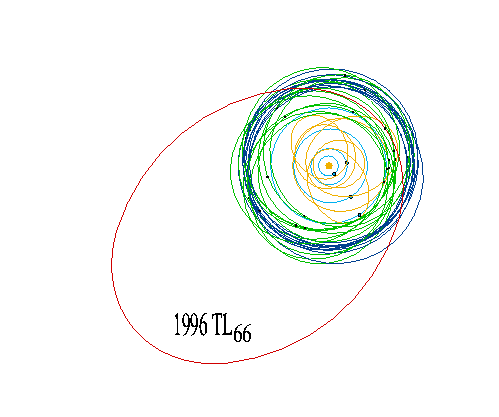 So what we have now are the rocky planets Mercury, Venus, Earth, Mars.
Then the asteroids.
In the outer solar system are the giant planets
Jupiter, Saturn, Uranus, Neptune.
The "centaur" objects in between Saturn and
Uranus. These usually act like asteroids, but every once in a while
they have a coma, like a comet. Then we have the Kuiper-belt objects,
left over from the icy objects that were in pretty stable spots.
These sometimes get scattered in by the giant planets to become the
short-period comets.
Way out here somewhere we have the Oort cloud, from the small icy objects
that were NOT in stable orbits. They get scattered in by who knows what
to become the long-period comets. Then just this last year there
is a new kind of orbit. We don't know yet if this is just a large,
eccentric KBO, or if this is the beginning of a gradual fade into the
Oort cloud.
In any case, life moves slowly out past Neptune, so scientists
like to study comets in the hope that they haven't been changed much
since the solar system was formed. So the comets can tell us what
the nebula of gas aroundthe sun was like, when the planets were being made.
So much from where comets come from. Where are they going?
Well, we know part of the answer already: we see their tails, and
we know that all that dust and gas was once part of the comet.
It takes about 500 orbits of the comet around the sun to loose
everything that can evaporate, and turn into a dead comet. In fact,
up to a third of the asteroids may be dead comets.
So what we have now are the rocky planets Mercury, Venus, Earth, Mars.
Then the asteroids.
In the outer solar system are the giant planets
Jupiter, Saturn, Uranus, Neptune.
The "centaur" objects in between Saturn and
Uranus. These usually act like asteroids, but every once in a while
they have a coma, like a comet. Then we have the Kuiper-belt objects,
left over from the icy objects that were in pretty stable spots.
These sometimes get scattered in by the giant planets to become the
short-period comets.
Way out here somewhere we have the Oort cloud, from the small icy objects
that were NOT in stable orbits. They get scattered in by who knows what
to become the long-period comets. Then just this last year there
is a new kind of orbit. We don't know yet if this is just a large,
eccentric KBO, or if this is the beginning of a gradual fade into the
Oort cloud.
In any case, life moves slowly out past Neptune, so scientists
like to study comets in the hope that they haven't been changed much
since the solar system was formed. So the comets can tell us what
the nebula of gas aroundthe sun was like, when the planets were being made.
So much from where comets come from. Where are they going?
Well, we know part of the answer already: we see their tails, and
we know that all that dust and gas was once part of the comet.
It takes about 500 orbits of the comet around the sun to loose
everything that can evaporate, and turn into a dead comet. In fact,
up to a third of the asteroids may be dead comets.
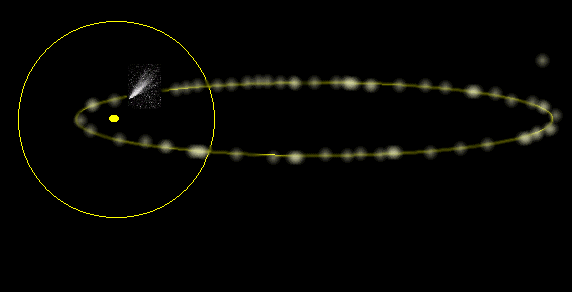 And what happens to the junk that's spewed off from the comet? Some
of it remains in the comet's orbit. When the Earth crosses the
orbit, the comet junk burns up in our atmosphere, making
meteor showers, or shooting stars. The persied showers, that happened
this week, happen when the Earth passes near the comet Swift-Tuttle.
The Leonid showers, in November, are from the comet Tempel-Tuttle
(Tuttel was a busy guy). In 1998 and 1999, the Earth will pass
close to the comet itself, so the show might be worth braving the
cold for.
Some comets never get this quiet death.
They get a slingshot course correction by Jupiter and
get slung out of the solar system, never to be seen again. Or,
the other way around, they head into the sun.
If they get too close to Jupiter, the comet doesn't just change its orbit,
it goes into orbit around Jupiter. But this can't last.
It breaks abart from the tidal forces. Jupiter is pulling on the
piece of the comet closest to it, harder than it's pulling on the far side.
This is what happened to Shoemaker-Levy 9, and what made the famous
"string of pearls" out of that comet. And we all know what happened
to Shoemaker-Levy 9 at the end, in July 1994. It crashed into Jupiter,
raising huge fireballs, leaving black spots on Jupiter that lsated for weeks.
But no more comet.
And what happens to the junk that's spewed off from the comet? Some
of it remains in the comet's orbit. When the Earth crosses the
orbit, the comet junk burns up in our atmosphere, making
meteor showers, or shooting stars. The persied showers, that happened
this week, happen when the Earth passes near the comet Swift-Tuttle.
The Leonid showers, in November, are from the comet Tempel-Tuttle
(Tuttel was a busy guy). In 1998 and 1999, the Earth will pass
close to the comet itself, so the show might be worth braving the
cold for.
Some comets never get this quiet death.
They get a slingshot course correction by Jupiter and
get slung out of the solar system, never to be seen again. Or,
the other way around, they head into the sun.
If they get too close to Jupiter, the comet doesn't just change its orbit,
it goes into orbit around Jupiter. But this can't last.
It breaks abart from the tidal forces. Jupiter is pulling on the
piece of the comet closest to it, harder than it's pulling on the far side.
This is what happened to Shoemaker-Levy 9, and what made the famous
"string of pearls" out of that comet. And we all know what happened
to Shoemaker-Levy 9 at the end, in July 1994. It crashed into Jupiter,
raising huge fireballs, leaving black spots on Jupiter that lsated for weeks.
But no more comet.
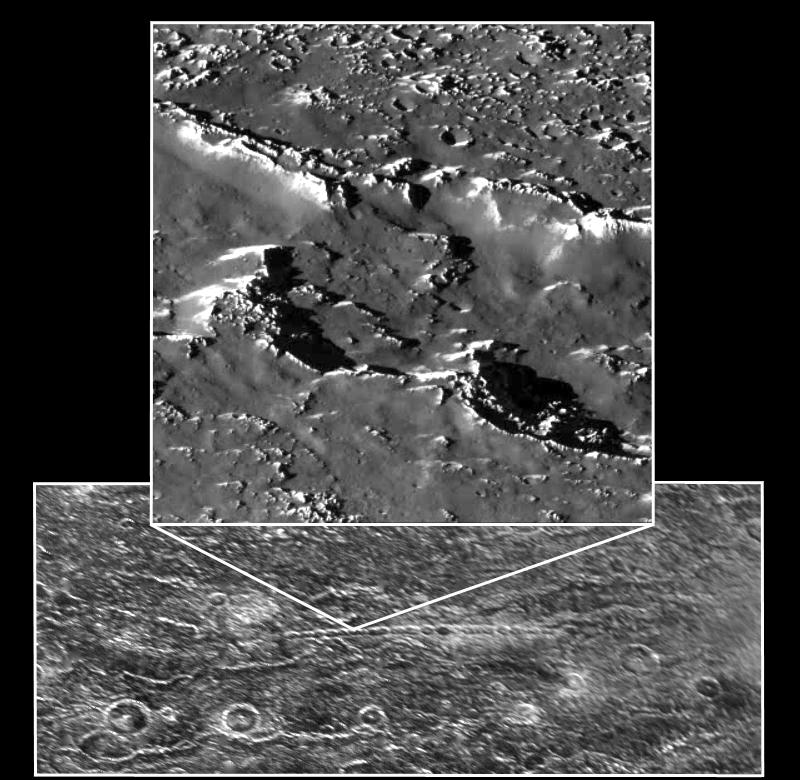 We now know that's happened before. This is a picture of Callisto,
a moon of Jupiter. Before Shoemake-Levy 9, this was just plain wierd,
But now we know we're looking at a crater chain. There was, once upon a time,
another comet like Showmaker-Levy 9, that also got captured by
Jupiter and split up. Except this one never made it all the way around
to eventually impact onto Jupiter. Callisto got in the way, and here's
the crates made by each individual piece.
We now know that's happened before. This is a picture of Callisto,
a moon of Jupiter. Before Shoemake-Levy 9, this was just plain wierd,
But now we know we're looking at a crater chain. There was, once upon a time,
another comet like Showmaker-Levy 9, that also got captured by
Jupiter and split up. Except this one never made it all the way around
to eventually impact onto Jupiter. Callisto got in the way, and here's
the crates made by each individual piece.
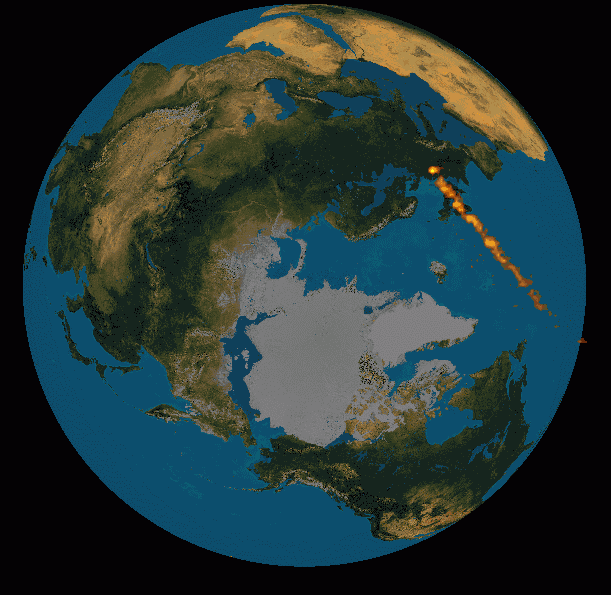 This also happens here on the Earth. A chain of craters was seen in Chad,
from the space shuttle, using radar imaging in April and October 1994.
This looks like the same kind of break-up. Not only that, but
the Earth is bombarded with 5 - 30 house-sized comets every minute.
This is a UV image of the breakup of a small comet, superimposed
on a picture of the Earth for reference.
These small comets pose no danger at all.
This also happens here on the Earth. A chain of craters was seen in Chad,
from the space shuttle, using radar imaging in April and October 1994.
This looks like the same kind of break-up. Not only that, but
the Earth is bombarded with 5 - 30 house-sized comets every minute.
This is a UV image of the breakup of a small comet, superimposed
on a picture of the Earth for reference.
These small comets pose no danger at all.
 And 66 million years ago, a 6-mile wide comet slammed into the
Yukatan penninsula. Global fires, killing off 1/4 of the plants.
Messing up the oceans, stirring up the oceans and bringing up the deep,
oxygen poor water.
And 66 million years ago, a 6-mile wide comet slammed into the
Yukatan penninsula. Global fires, killing off 1/4 of the plants.
Messing up the oceans, stirring up the oceans and bringing up the deep,
oxygen poor water.
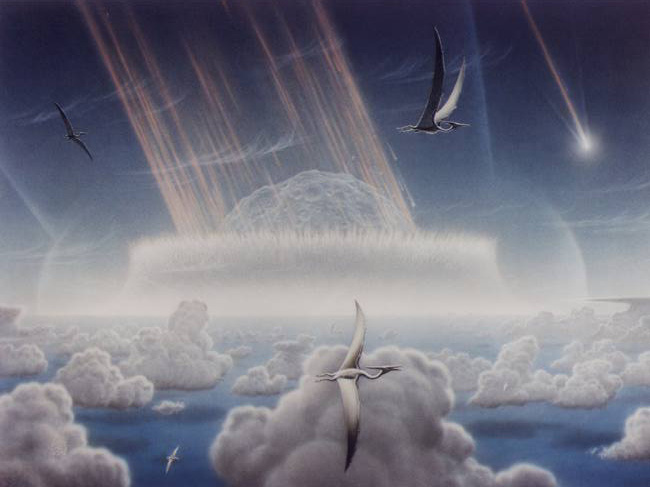 But, as a final note, many scientists believe that most of the Earth's
ocean and atmosphere was brought by comet impacts AFTER the Earth
had formed. So if the idea of cometary impacts is scary, think how much
more good they've done than harm.
But, as a final note, many scientists believe that most of the Earth's
ocean and atmosphere was brought by comet impacts AFTER the Earth
had formed. So if the idea of cometary impacts is scary, think how much
more good they've done than harm.
 Hyakutake was discovered only in January 1996, and already by the biggining
of March it
was visible. It was
visible just a few weeks at the end of March, beginning of April,
but was up all night, and
had a really good tail from dark sites.
Some people reported seeing a tail that was 30, 40, 50, even 100 degrees long.
Approached the Earth March 24-25.
Hyakutake was discovered only in January 1996, and already by the biggining
of March it
was visible. It was
visible just a few weeks at the end of March, beginning of April,
but was up all night, and
had a really good tail from dark sites.
Some people reported seeing a tail that was 30, 40, 50, even 100 degrees long.
Approached the Earth March 24-25.
 Hale-Bopp was discovered July 1995.
Hale-Bopp was bright, but only visible at sunrise at the beginning and
then, later, just after sunset. Visible for several months.
Here we see that Hale-Bopp was "stubbier." Also we see two
tails here. One is bluer, and that's the "ion tail." and
the other one is less blue, and that's the dust tail.
Why are the comets so different? Before we do that, we have to
talk about what a comet is. In 1950, Fred Whipple wrote a paper
describing comets as "dirty snowballs."
And that basic description has held up, even though some scientist
will quibble and say that comets are really "icy mudballs."
In any case, they are a mixture of rock and frozen water, with
some other things mixed in. Methane, ammonia, other gases.
Hale-Bopp was discovered July 1995.
Hale-Bopp was bright, but only visible at sunrise at the beginning and
then, later, just after sunset. Visible for several months.
Here we see that Hale-Bopp was "stubbier." Also we see two
tails here. One is bluer, and that's the "ion tail." and
the other one is less blue, and that's the dust tail.
Why are the comets so different? Before we do that, we have to
talk about what a comet is. In 1950, Fred Whipple wrote a paper
describing comets as "dirty snowballs."
And that basic description has held up, even though some scientist
will quibble and say that comets are really "icy mudballs."
In any case, they are a mixture of rock and frozen water, with
some other things mixed in. Methane, ammonia, other gases.
 Comets orbit the sun in ellipses, just like Earth and the other planets do.
But the orbits of the comets are long and stretched out. We say
the orbits are "eccentric" (and some of the people studying comets
are eccentric as well.) And like all the objects that orbit the
sun, the comet moves fastest when it is closest to the sun.
This means that a comet would be a lousy place to live. You'd
spent 20 to 20,000 years in cold darkness. Then boom -- a few
warm months, maybe too warm, and then you zip back out to the
outer solar system again.
Comets orbit the sun in ellipses, just like Earth and the other planets do.
But the orbits of the comets are long and stretched out. We say
the orbits are "eccentric" (and some of the people studying comets
are eccentric as well.) And like all the objects that orbit the
sun, the comet moves fastest when it is closest to the sun.
This means that a comet would be a lousy place to live. You'd
spent 20 to 20,000 years in cold darkness. Then boom -- a few
warm months, maybe too warm, and then you zip back out to the
outer solar system again.
 The sun is so faint out past Saturn that ice acts like rock.
It doesn't melt ... it doesn't even sublime straight from ice to
gas, the way ice cubes do when you fill your tray, and then 3 months
later you check the freezer and the ice cubes trays all look like they're
half full.
At this time, comets are just the small, nucleus of the dirty snowball.
They are tiny. Typically just a few km across.
Even comet Halley is only 7-10 miles across,
you could bike around a comet in a few hours.
Also comets are very dark. Darker than charcoal.
This means that most of the time, comets are vary hard to detect, even
with major telescopes. There's only a few people studying distant comets.
When a comet approaches the inner solar system, everything changes.
As the sun heats up the surface, gas begins to escape
from the comet. It takes the dust up with it, like a wind picking up dust.
This is small dust -- smoke-particle size. Eventually, the dust and gas
makes a large diffuse cloud around the comet, and you get a "coma,"
the gas and dust around the comet, about 100,000 km = tens of thousands of mi
wide. This is what makes the comet look "fuzzy". The gases in the
coma come from the comet nucleus: water, carbon monoxide, carbon dioxide,
some methane, some ammonia, some other stuff.
As the comet gets closer to the sun, the comet grows tails.
The skinny blue tail is the ion tail. This is made of electrically
charged gases, and it points directly away from the sun, because the
charged gases are trapped in the Sun's magnetric field. The other
tail is made up of dust, and the radiation pressure of the
sunlight pushes it more-or-less away from the sun, but this
tail CAN curve away from the strict anti-solar direction, so you
see two tails. Pretty. Hale-Bopps' tail was 50-60 million miles long.
The sun is so faint out past Saturn that ice acts like rock.
It doesn't melt ... it doesn't even sublime straight from ice to
gas, the way ice cubes do when you fill your tray, and then 3 months
later you check the freezer and the ice cubes trays all look like they're
half full.
At this time, comets are just the small, nucleus of the dirty snowball.
They are tiny. Typically just a few km across.
Even comet Halley is only 7-10 miles across,
you could bike around a comet in a few hours.
Also comets are very dark. Darker than charcoal.
This means that most of the time, comets are vary hard to detect, even
with major telescopes. There's only a few people studying distant comets.
When a comet approaches the inner solar system, everything changes.
As the sun heats up the surface, gas begins to escape
from the comet. It takes the dust up with it, like a wind picking up dust.
This is small dust -- smoke-particle size. Eventually, the dust and gas
makes a large diffuse cloud around the comet, and you get a "coma,"
the gas and dust around the comet, about 100,000 km = tens of thousands of mi
wide. This is what makes the comet look "fuzzy". The gases in the
coma come from the comet nucleus: water, carbon monoxide, carbon dioxide,
some methane, some ammonia, some other stuff.
As the comet gets closer to the sun, the comet grows tails.
The skinny blue tail is the ion tail. This is made of electrically
charged gases, and it points directly away from the sun, because the
charged gases are trapped in the Sun's magnetric field. The other
tail is made up of dust, and the radiation pressure of the
sunlight pushes it more-or-less away from the sun, but this
tail CAN curve away from the strict anti-solar direction, so you
see two tails. Pretty. Hale-Bopps' tail was 50-60 million miles long.
 When you look at the very center of the comet with a good telescope,
you can see a spiral. The gases are not coming out smoothly.
Instead it is coming out as jets. And as the nucleus rotates,
you get a spiral.
When you look at the very center of the comet with a good telescope,
you can see a spiral. The gases are not coming out smoothly.
Instead it is coming out as jets. And as the nucleus rotates,
you get a spiral.
 This is because a crust is forming. Each time the comet passes
near the sun, it can loose several yards of ice and dust. The ice
leaves more easily than the dust ... after all, it's the ice
that sublimes,and the dust just comes along for the ride. The result
is that the dust is left behind. Like a huge, extreme version of
what happens to the pile of snow plowed into the corner of the
parking lot. Where the crust is thinner, that's where you'll
have the jets.
This is because a crust is forming. Each time the comet passes
near the sun, it can loose several yards of ice and dust. The ice
leaves more easily than the dust ... after all, it's the ice
that sublimes,and the dust just comes along for the ride. The result
is that the dust is left behind. Like a huge, extreme version of
what happens to the pile of snow plowed into the corner of the
parking lot. Where the crust is thinner, that's where you'll
have the jets.
 So what does this have to do with why Hale-Bopp and Hyakutake looked
so different? Hyakutake was actually not much of a comet.
Its nucleus was only about 1 mi across. It had hardly any dust.
Since it was so naturally dim, it was only discovered a few months
before it was visible. But, it had a great orbit!
Look how close to the Earth it got. This is the orbit of the
Earth, and this is the sun, and this is Hyakutake, screaming in
on this long, streached-out orbit. In March, it's 1/10 the
distance from us as the sun is. And it's nearly north of the
Earth, which means that we lucky Norhtern herisphere folks
could watch it all night.
So what does this have to do with why Hale-Bopp and Hyakutake looked
so different? Hyakutake was actually not much of a comet.
Its nucleus was only about 1 mi across. It had hardly any dust.
Since it was so naturally dim, it was only discovered a few months
before it was visible. But, it had a great orbit!
Look how close to the Earth it got. This is the orbit of the
Earth, and this is the sun, and this is Hyakutake, screaming in
on this long, streached-out orbit. In March, it's 1/10 the
distance from us as the sun is. And it's nearly north of the
Earth, which means that we lucky Norhtern herisphere folks
could watch it all night.
 Hale-Bopp also has a stretched-out orbit, but not nearly so skinny.
That means that it has a smaller orbit than Hyakutake, and so a
shorter period. Hale-Bopp was last here 4300 years ago,
Hale-Bopp last visited us 4300 years ago. Will visit us again 2300 years
from now.
Hyakutake last visited us 17,500 years ago and will not return for
another 29,500 years.
Like Hyakutake, the orbit is coming up at right angles to the
plane the planets generally move in.
But, unlike Hyakutake, the comet only got a little closer to us
that the sun is (0.9 AU).
HB was 100x brigher, but 13 times farther.
Also, since the tail always points away
from the sun, like a windsock, the tail is forshortened. Still,
since Hale-Bopp is a dusty, large comet, it was still bright.
And we say it coming a year and a half in advance. It's twice as
big as Halley's comet.
Hale-Bopp also has a stretched-out orbit, but not nearly so skinny.
That means that it has a smaller orbit than Hyakutake, and so a
shorter period. Hale-Bopp was last here 4300 years ago,
Hale-Bopp last visited us 4300 years ago. Will visit us again 2300 years
from now.
Hyakutake last visited us 17,500 years ago and will not return for
another 29,500 years.
Like Hyakutake, the orbit is coming up at right angles to the
plane the planets generally move in.
But, unlike Hyakutake, the comet only got a little closer to us
that the sun is (0.9 AU).
HB was 100x brigher, but 13 times farther.
Also, since the tail always points away
from the sun, like a windsock, the tail is forshortened. Still,
since Hale-Bopp is a dusty, large comet, it was still bright.
And we say it coming a year and a half in advance. It's twice as
big as Halley's comet.
 See, gas molecules emit light (shine) at specific wavelengths (colors).
This is called a spectrum.
If you plot brightness as a function of wavelength, you see what
molecules are in the comet because of the spectrum.
It's like a fingerprint,
each molecule shines at it's own colors. Here's a spectrum of Hale-Bopp
showing the sodium lines in late April.
See, gas molecules emit light (shine) at specific wavelengths (colors).
This is called a spectrum.
If you plot brightness as a function of wavelength, you see what
molecules are in the comet because of the spectrum.
It's like a fingerprint,
each molecule shines at it's own colors. Here's a spectrum of Hale-Bopp
showing the sodium lines in late April.
 Observers at La Palma telescope in Spain at 18 April 1997 took images with
a filter that isolates emission from sodium atoms. In other words, they
used a finter that blocked off all but this part, and then they
took an picture. The next step is to take a picture without this bump.
The difference between the two has to be from the sodium.
600,000 km wide and 50 million km long tail, in a
direction close but slightly different to that of the ion tail.
This is a narrow feature.
Observers at La Palma telescope in Spain at 18 April 1997 took images with
a filter that isolates emission from sodium atoms. In other words, they
used a finter that blocked off all but this part, and then they
took an picture. The next step is to take a picture without this bump.
The difference between the two has to be from the sodium.
600,000 km wide and 50 million km long tail, in a
direction close but slightly different to that of the ion tail.
This is a narrow feature.
 The sodium tail was also seen in March
from McDonald Observatory in Texas by observers from BU, and this
time the tail was broad -- broader than either the dust or the ion tails.
So it looks like there may be two sources for this sodium tail --
sometimes it is coming directly from the nucleus and sometimes from the
dust tail.
The sodium tail was also seen in March
from McDonald Observatory in Texas by observers from BU, and this
time the tail was broad -- broader than either the dust or the ion tails.
So it looks like there may be two sources for this sodium tail --
sometimes it is coming directly from the nucleus and sometimes from the
dust tail.
 Nine hundred years ago, they thought that
comets were signs from God. When King Harold,
king of the Saxons, saw Halley's comet in 1066, he
thought it was a portent of doom. Actually, maybe he should have
stayed in bed after all, because he ended up loosing hte
Battle of Hastings to Duke William, leader of the Normans, later that year.
Nine hundred years ago, they thought that
comets were signs from God. When King Harold,
king of the Saxons, saw Halley's comet in 1066, he
thought it was a portent of doom. Actually, maybe he should have
stayed in bed after all, because he ended up loosing hte
Battle of Hastings to Duke William, leader of the Normans, later that year.
 So what we have now are the rocky planets Mercury, Venus, Earth, Mars.
Then the asteroids.
In the outer solar system are the giant planets
Jupiter, Saturn, Uranus, Neptune.
The "centaur" objects in between Saturn and
Uranus. These usually act like asteroids, but every once in a while
they have a coma, like a comet. Then we have the Kuiper-belt objects,
left over from the icy objects that were in pretty stable spots.
These sometimes get scattered in by the giant planets to become the
short-period comets.
Way out here somewhere we have the Oort cloud, from the small icy objects
that were NOT in stable orbits. They get scattered in by who knows what
to become the long-period comets. Then just this last year there
is a new kind of orbit. We don't know yet if this is just a large,
eccentric KBO, or if this is the beginning of a gradual fade into the
Oort cloud.
In any case, life moves slowly out past Neptune, so scientists
like to study comets in the hope that they haven't been changed much
since the solar system was formed. So the comets can tell us what
the nebula of gas aroundthe sun was like, when the planets were being made.
So much from where comets come from. Where are they going?
Well, we know part of the answer already: we see their tails, and
we know that all that dust and gas was once part of the comet.
It takes about 500 orbits of the comet around the sun to loose
everything that can evaporate, and turn into a dead comet. In fact,
up to a third of the asteroids may be dead comets.
So what we have now are the rocky planets Mercury, Venus, Earth, Mars.
Then the asteroids.
In the outer solar system are the giant planets
Jupiter, Saturn, Uranus, Neptune.
The "centaur" objects in between Saturn and
Uranus. These usually act like asteroids, but every once in a while
they have a coma, like a comet. Then we have the Kuiper-belt objects,
left over from the icy objects that were in pretty stable spots.
These sometimes get scattered in by the giant planets to become the
short-period comets.
Way out here somewhere we have the Oort cloud, from the small icy objects
that were NOT in stable orbits. They get scattered in by who knows what
to become the long-period comets. Then just this last year there
is a new kind of orbit. We don't know yet if this is just a large,
eccentric KBO, or if this is the beginning of a gradual fade into the
Oort cloud.
In any case, life moves slowly out past Neptune, so scientists
like to study comets in the hope that they haven't been changed much
since the solar system was formed. So the comets can tell us what
the nebula of gas aroundthe sun was like, when the planets were being made.
So much from where comets come from. Where are they going?
Well, we know part of the answer already: we see their tails, and
we know that all that dust and gas was once part of the comet.
It takes about 500 orbits of the comet around the sun to loose
everything that can evaporate, and turn into a dead comet. In fact,
up to a third of the asteroids may be dead comets.
 And what happens to the junk that's spewed off from the comet? Some
of it remains in the comet's orbit. When the Earth crosses the
orbit, the comet junk burns up in our atmosphere, making
meteor showers, or shooting stars. The persied showers, that happened
this week, happen when the Earth passes near the comet Swift-Tuttle.
The Leonid showers, in November, are from the comet Tempel-Tuttle
(Tuttel was a busy guy). In 1998 and 1999, the Earth will pass
close to the comet itself, so the show might be worth braving the
cold for.
Some comets never get this quiet death.
They get a slingshot course correction by Jupiter and
get slung out of the solar system, never to be seen again. Or,
the other way around, they head into the sun.
If they get too close to Jupiter, the comet doesn't just change its orbit,
it goes into orbit around Jupiter. But this can't last.
It breaks abart from the tidal forces. Jupiter is pulling on the
piece of the comet closest to it, harder than it's pulling on the far side.
This is what happened to Shoemaker-Levy 9, and what made the famous
"string of pearls" out of that comet. And we all know what happened
to Shoemaker-Levy 9 at the end, in July 1994. It crashed into Jupiter,
raising huge fireballs, leaving black spots on Jupiter that lsated for weeks.
But no more comet.
And what happens to the junk that's spewed off from the comet? Some
of it remains in the comet's orbit. When the Earth crosses the
orbit, the comet junk burns up in our atmosphere, making
meteor showers, or shooting stars. The persied showers, that happened
this week, happen when the Earth passes near the comet Swift-Tuttle.
The Leonid showers, in November, are from the comet Tempel-Tuttle
(Tuttel was a busy guy). In 1998 and 1999, the Earth will pass
close to the comet itself, so the show might be worth braving the
cold for.
Some comets never get this quiet death.
They get a slingshot course correction by Jupiter and
get slung out of the solar system, never to be seen again. Or,
the other way around, they head into the sun.
If they get too close to Jupiter, the comet doesn't just change its orbit,
it goes into orbit around Jupiter. But this can't last.
It breaks abart from the tidal forces. Jupiter is pulling on the
piece of the comet closest to it, harder than it's pulling on the far side.
This is what happened to Shoemaker-Levy 9, and what made the famous
"string of pearls" out of that comet. And we all know what happened
to Shoemaker-Levy 9 at the end, in July 1994. It crashed into Jupiter,
raising huge fireballs, leaving black spots on Jupiter that lsated for weeks.
But no more comet.
 We now know that's happened before. This is a picture of Callisto,
a moon of Jupiter. Before Shoemake-Levy 9, this was just plain wierd,
But now we know we're looking at a crater chain. There was, once upon a time,
another comet like Showmaker-Levy 9, that also got captured by
Jupiter and split up. Except this one never made it all the way around
to eventually impact onto Jupiter. Callisto got in the way, and here's
the crates made by each individual piece.
We now know that's happened before. This is a picture of Callisto,
a moon of Jupiter. Before Shoemake-Levy 9, this was just plain wierd,
But now we know we're looking at a crater chain. There was, once upon a time,
another comet like Showmaker-Levy 9, that also got captured by
Jupiter and split up. Except this one never made it all the way around
to eventually impact onto Jupiter. Callisto got in the way, and here's
the crates made by each individual piece.
 This also happens here on the Earth. A chain of craters was seen in Chad,
from the space shuttle, using radar imaging in April and October 1994.
This looks like the same kind of break-up. Not only that, but
the Earth is bombarded with 5 - 30 house-sized comets every minute.
This is a UV image of the breakup of a small comet, superimposed
on a picture of the Earth for reference.
These small comets pose no danger at all.
This also happens here on the Earth. A chain of craters was seen in Chad,
from the space shuttle, using radar imaging in April and October 1994.
This looks like the same kind of break-up. Not only that, but
the Earth is bombarded with 5 - 30 house-sized comets every minute.
This is a UV image of the breakup of a small comet, superimposed
on a picture of the Earth for reference.
These small comets pose no danger at all.
 And 66 million years ago, a 6-mile wide comet slammed into the
Yukatan penninsula. Global fires, killing off 1/4 of the plants.
Messing up the oceans, stirring up the oceans and bringing up the deep,
oxygen poor water.
And 66 million years ago, a 6-mile wide comet slammed into the
Yukatan penninsula. Global fires, killing off 1/4 of the plants.
Messing up the oceans, stirring up the oceans and bringing up the deep,
oxygen poor water.
 But, as a final note, many scientists believe that most of the Earth's
ocean and atmosphere was brought by comet impacts AFTER the Earth
had formed. So if the idea of cometary impacts is scary, think how much
more good they've done than harm.
But, as a final note, many scientists believe that most of the Earth's
ocean and atmosphere was brought by comet impacts AFTER the Earth
had formed. So if the idea of cometary impacts is scary, think how much
more good they've done than harm.